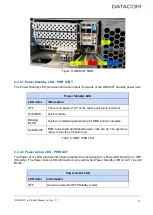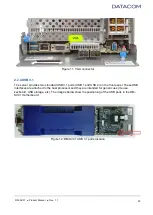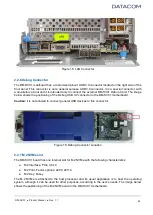
DM-
SV01 ● Product Manual ● Rev. 1.1
7
1.1 OCP (Open Compute Project) Concept Fundamentals
In 2009, Facebook started a project to redesign their data centers in order to control cost and energy
consumption. A small team of engineers spent the next two years designing a new generation of data
centers, which resulted in a solution 38% more energy efficient to build and 24% less expensive to run
than the company’s previous facilities.
In 2011, Facebook made its design public alongside the launch of the Open Compute Project (OCP)
Foundation. The five founding members of the initiative expected to create a movement in the hardware
atmosphere that would lead to the same kind of creativity and collaboration seen in open source
software. Nowadays, OCP concepts are well established among cloud datacenters.
During the initial OCP development the engineers had freedom to change many established concepts,
with focus on reducing power usage and operating costs. These changes resulted in the definition of
some characteristics of the OCP concept, such as those described below.
●
Rack with centralized power supplies
OCP racks have one or two centralized power shelves on the rack instead of multiple power supply
units in each server chassis. The power is distributed at 12.5Vdc by means of a busbar on the back of
the rack to all servers and storage systems.
The centralized power concept allows power modules in the shelf to operate at the optimum point of
the efficiency-vs-load curve, thus optimizing energy consumption.
There is no need for a redundant power supply connected on each server anymore, since the power
modules in the rack operate in parallel. The customer may define the amount of redundant power to be
reserved in an m+n scheme.
●
Front access design and maintenance
The concept of power distribution located on the backside of the rack via a 12Vdc busbar eliminates a
bunch of AC cables and PDUs (Power Distribution Units), reducing rack cabling and maintenance
efforts.
Compared to traditional 19” servers, the OCP approach regarding server access is different, once all
connections are performed on the front side only. This solution makes the rack cabling and maintenance
processes easier, once the server handling is done only on the cold aisle.
●
Disaggregation and system lifecycle
The servers are designed in such a way to improve serviceability and to be handled without the need
of tools. The parts can be easily replaced, minimizing the time spent with service and improving the
availability.
Traditional servers combine many components with different life cycles. Separating power and storage
nodes from computing allows the upgrading of each component at the optimal point of the life cycle,
resulting in increased lifetime cost efficiency.








































